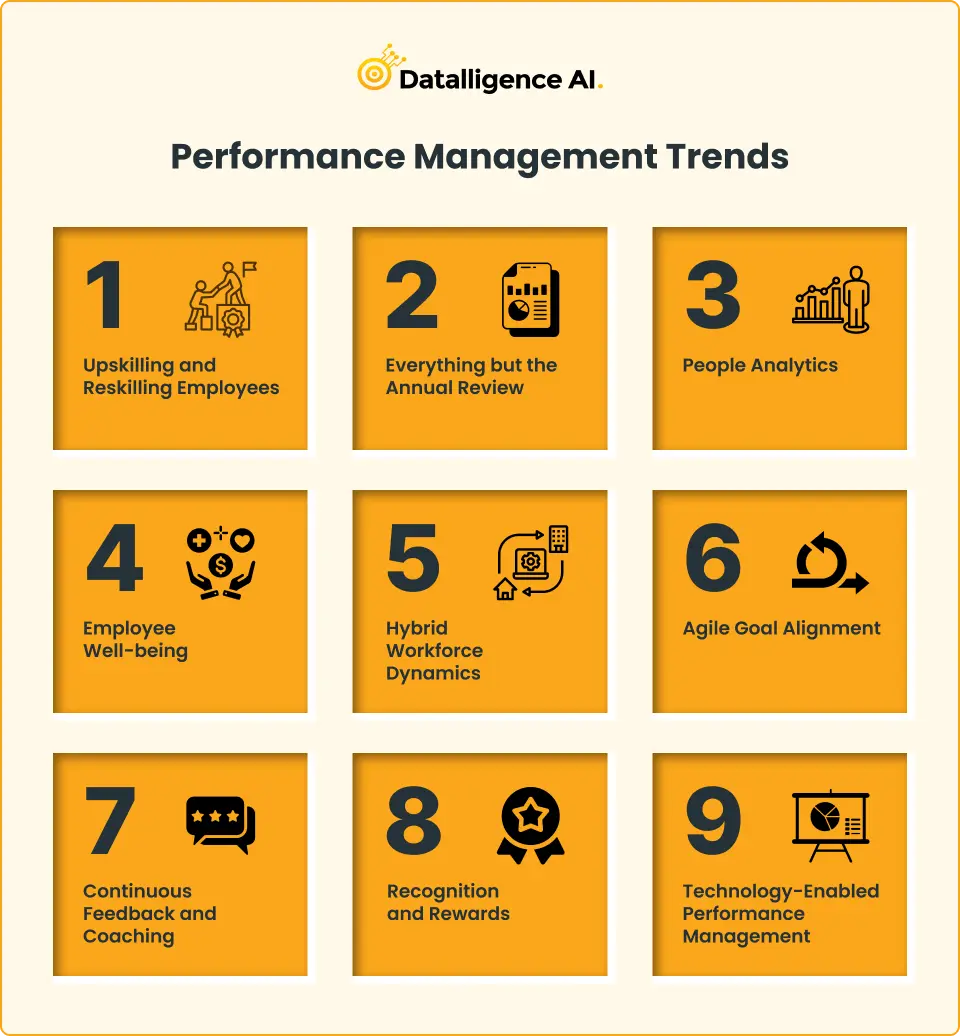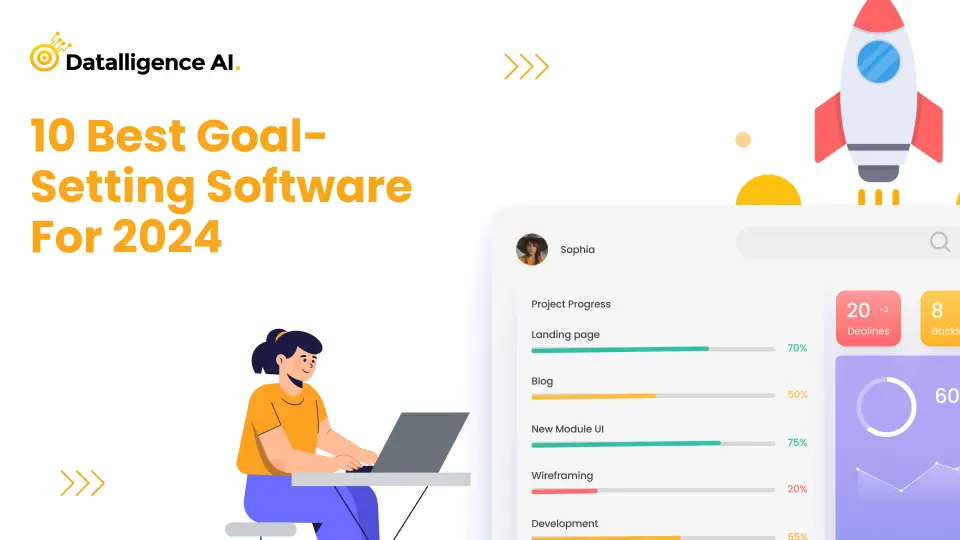In the United States in 2023 and beyond, performance management is evolving in response to the dynamic nature of the modern workplace. The latest trends in performance management emphasize a move away from traditional, annual performance reviews in favor of continuous and agile feedback processes. This shift recognizes the need for real-time assessments and frequent engagement between managers and employees, focusing on driving improvement consistently.
Another key trend is the shift toward holistic development. Companies are now invested in nurturing their employees’ potential, encompassing skill development, career planning, and personal growth. Aligning individual objectives with organizational goals is central to this approach.
Diversity, equity, and inclusion (DEI) are also at the forefront of performance management trends, with organizations using data-driven insights to address bias and disparities in employee performance evaluations. Leveraging technology, adapting to remote and hybrid work arrangements, and enhancing employer branding are essential strategies as performance management continues to evolve in the USA, ensuring companies can boost performance in this changing landscape.
Performance Management Trends: Boosting Performance in the Evolving Workplace

In the fast-paced and dynamic world of work, organizations must continuously adapt their performance management strategies to keep up with evolving trends. Performance management plays a crucial role in maximizing the potential of employees and driving organizational success. In this article, we will explore the new trends in performance management trends that can help boost performance and engagement in the evolving workplace.
1. Upskilling and Reskilling Employees
With a growing skills gap and the increasing demand for qualified talent, organizations are prioritizing upskilling and reskilling their existing workforce. According to a survey of HR professionals, 83% of them are struggling to find qualified candidates for skilled roles. This shortage of skilled talent is expected to be a significant challenge for CEOs in the future.
To address this issue, organizations are implementing strategies to close skills gaps through targeted employee training, rewarding employees for learning new skills, and providing experiential learning opportunities. By investing in the professional development of their employees, organizations can boost employee confidence, open doors for career advancement, and expand their employees’ knowledge base.
2. Everything but the Annual Review
Traditional annual performance reviews are often seen as unfair and incomplete, leading to dissatisfaction among employees. Many employees perceive these reviews as subjective and biased, which can harm company culture and even lead to turnover. In response, organizations are adopting alternative methods to evaluate performance.
Peer and 360-degree feedback, project-based appraisals, continuous feedback through regular one-on-one meetings, and aligned goal-setting are some of the approaches organizations are using to provide fairer and more comprehensive evaluations. These alternative methods enhance employee engagement, provide different perspectives on performance, and enable timely rewards and recognition.
3. People Analytics
In 2023, HR leaders are increasingly relying on people analytics to gain insights into employee performance, motivation, and retention. People analytics involves analyzing employee data to understand trends, identify patterns, and make data-informed decisions. By leveraging people analytics, organizations can uncover the factors influencing employee performance and take steps to maximize talent potential.
For example, through performance analytics, organizations can identify trends such as lower performance ratings for remote employees compared to hybrid workers. This insight prompts further investigation into potential factors such as training needs for reviewers, resource gaps for remote work, and the effectiveness of remote workforce management.
4. Employee Well-being
Employee well-being has emerged as a top priority for organizations, particularly in light of the global health crisis. A significant percentage of employees report feeling stressed at work and believe that their employers do not prioritize their well-being. To address this, organizations are implementing strategies to promote employee well-being and improve overall performance.
Flexible work arrangements, employee assistance programs, and mentorship and career development opportunities are some of the initiatives organizations are adopting to support employee well-being. When employees feel supported and empowered to lead healthy lives, they are more engaged, less likely to experience burnout, and more likely to stay with the organization.
5. Hybrid Workforce Dynamics
The COVID-19 pandemic has accelerated the shift towards remote and hybrid work models. Many organizations have embraced remote work, and a significant percentage of employees prefer a hybrid work arrangement. As a result, organizations are reevaluating their performance management strategies to accommodate the unique dynamics of a hybrid workforce.
To effectively manage a hybrid workforce, organizations are implementing regular check-ins using communication platforms, providing tools and resources for remote onboarding and leadership training, and designing engagement programs that foster connection and collaboration among remote and in-office employees. By adapting performance management to the hybrid work environment, organizations can maintain productivity and engagement across their workforce.
6. Agile Goal Alignment
Traditional goal-setting approaches often lack flexibility and fail to keep up with rapidly changing business environments. In response, organizations are adopting agile goal alignment practices to ensure that goals remain relevant and aligned with dynamic business priorities.
Agile goal alignment involves setting goals that are clear, measurable, and adaptable to changing circumstances. Regular check-ins and feedback sessions allow for adjustments and ensure that employees stay aligned with organizational objectives. By embracing agile goal alignment, organizations can enhance employee motivation, foster a sense of ownership, and drive performance in a changing work landscape.
7. Continuous Feedback and Coaching
The need for continuous feedback and coaching is gaining recognition as an essential component of effective performance management. Traditional annual reviews are being replaced by ongoing feedback and coaching conversations that provide real-time guidance and support.
Regular one-on-one meetings between managers and employees offer an opportunity for open communication, goal progress review, and skill development discussions. This ongoing feedback and coaching approach not only improves employee performance but also strengthens the manager-employee relationship and fosters a culture of continuous learning and improvement.
8. Recognition and Rewards
Employee recognition and rewards have a significant impact on engagement and motivation. Organizations are moving away from traditional annual bonuses and adopting more frequent and personalized recognition programs.
By implementing recognition and rewards programs, organizations can acknowledge and celebrate employee achievements, reinforcing positive behaviors and boosting morale. This can include both formal recognition programs and informal gestures such as public appreciation, peer recognition, and rewards tailored to individual preferences.
9. Technology-Enabled Performance Management
Technology plays a crucial role in enhancing performance management processes. Organizations are leveraging performance management software and tools to automate and streamline various aspects of performance management.
Performance management software can facilitate goal tracking, feedback collection, performance reviews, and data analysis. These tools provide a centralized platform for managers and employees to collaborate, track progress, and access performance-related information. By harnessing technology, organizations can improve efficiency, accuracy, and accessibility in performance management processes.
Conclusion
As the workplace continues to evolve, organizations must stay ahead of the latest performance management trends to maximize employee potential, drive engagement, and achieve organizational success. By embracing upskilling initiatives, adopting alternative evaluation methods, leveraging people analytics, prioritizing employee well-being, and incorporating agile practices, organizations can create a performance-driven culture that thrives in the dynamic work landscape. Furthermore, continuous feedback, recognition and rewards, and technology-enabled performance management can further enhance performance and foster employee growth. By staying informed and adapting to these trends, organizations can create a high-performing workforce that is equipped to navigate the challenges and opportunities of the future.











